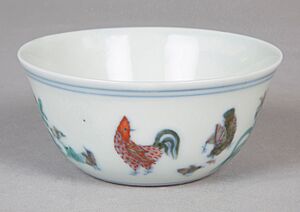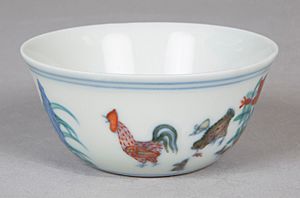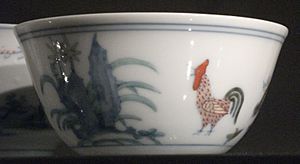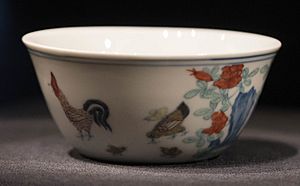Chicken Cup (Chenghua) facts for kids
Quick facts for kids The Chicken Cup |
|
|---|---|

Jingdezhen ware cup in the Metropolitan Museum of Art
|
|
| Material | Doucai porcelain with underglaze blue and overglaze coloured enamel |
| Size | Height: 4.1 cm (1.6 in) Diameter of rim: 8.3 cm (3.3 in) |
| Created | Chenghua period (1465-1487) |
| Period/culture | Ming Dynasty |
| Place | Jingdezhen, China |
A Chicken Cup is a small, bowl-shaped cup made from special Chinese porcelain. These cups are painted using a technique called doucai. Chicken Cups were first made during the Ming dynasty (1368 – 1644) in China. This was during the time of the Chenghua Emperor (1465 – 1487).
These cups were originally used for drinking wine. The Chenghua Emperor had them made at an imperial factory in Jingdezhen, Southern China. He created the Chicken Cup in the 15th century as a gift for his empress mother. She liked small objects and simple designs.
Chicken Cups are decorated with pictures of chickens, hens, and roosters. You can see a rooster and a hen feeding their young chick. They look like they are searching for worms and stretching their wings. The chickens on the cup represent important Chinese values. These include continuing the family line and taking care of the young.
Today, there are only thirteen real Chenghua cups in museums. Three more are owned by private collectors. The original Chenghua Chicken Cups do not have specific dates or artist names recorded.
Contents
Why are Chicken Cups so Special?
During the Chenghua Emperor's rule, imperial porcelain was very important. The imperial factory in Jingdezhen was set up in 1392. It was the main place that made porcelain for the emperor and his court. This factory was in the Jiangxi province of China.
Imperial porcelains, like the Chicken Cup, often had special symbols. These symbols showed the high status of the court. They also showed the amazing skills of potters from earlier times. During the Ming Dynasty, porcelain also started using more colors and designs. These could be painted underglaze (under the clear coating) or overglaze (on top of the coating).
Jingdezhen porcelain became famous worldwide. Large amounts of Chinese export porcelain were sent to Asia, Europe, and Africa. This happened between the 15th and 17th centuries.
Who Wanted Chicken Cups?
Many emperors and important people in China wanted Chicken Cups. Emperors from the Ming (1368-1644) and Qing (1644-1911) periods loved them. The Kangxi Emperor (1662-1722) was one of them. Other Chinese scholars and art lovers also sought them out.
The cups became even more popular during the Wanli Emperor's time (1572-1620). He admired Chenghua ceramics very much. Stories say that a rare Chenghua chicken cup was even stolen from his dining table! Old Chinese writings describe how much money nobles and emperors spent to get these cups in the 17th century.
Are There Fake Chicken Cups?
Yes, many Chicken Cups were copied during the Qing dynasty. The ways to make copies became very advanced in the 18th century. Fake Chicken Cups and other Jingdezhen porcelain were made in Southern Chinese kilns. These were sold to buyers in Southeast Asia. These copies were sometimes called Swatow wares.
Even inside the Imperial palace, some officials were involved in selling stolen cups. Today, copies are still made and sold at antique markets in China. They are often sold as if they were the original Chenghua cups.
How Chicken Cups Were Made
Making the Chicken Cup was a very complex process. This process became even better after the Xuande period. First, the design of the chicken cup was drawn onto the unbaked cup. This was done using a special blue color called cobalt blue. Then, the cup was covered with a clear glaze. After that, it was fired in a very hot oven called a kiln.
The glazing process used more aluminium oxide and less iron oxide. This made the porcelain strong enough for high temperatures. It also made the ceramic white and very dense. The high heat also made the cup's surface clear and soft. This is a special feature of these cups.
The chickens on the cup were first outlined in cobalt blue under the glaze. Then, colorful enamel paints were used to fill in the details. The soft blue color came from natural Chinese cobalt. Other types of cobalt, like Persian blue, were not available then. After painting, the cups were fired a second time at a lower temperature.
Making these cups was like an assembly line. Different groups of workers each painted different parts of the design. People believe these cups were made for the Chenghua Emperor's mother, Empress Dowager Wang.
Who Owns Chicken Cups Today?
Famous Collections
The National Palace Museum in Taipei has eight real Chenghua Chicken Cups. Five other museums also own these cups:
- The British Museum and Victoria and Albert Museum in London.
- The Fitzwilliam Museum in Cambridge.
- The Metropolitan Museum of Art in New York City.
- The Collections Baur in Geneva.
Three other Chenghua chicken cups are owned by private collectors. There are two cups in the Palace Museum in Beijing. The museum says they are Chenghua, but some Western experts are not sure.
Auction Sales
Chenghua Chicken Cups are so rare that they are usually only sold at special auctions. The international auction house, Sotheby's, has sold them. On August 8, 2014, a Chenghua chicken cup was sold in Hong Kong. It came from the private Meiyintang collection.
This cup was bought by a billionaire named Liu Yiqian for a record US$36.05 million. This was the highest price ever paid for Chinese porcelain at an auction. Before this, the record was held by a Qing Dynasty vase, sold for US$32.4 million in 2010.
This same Chicken Cup had been sold before. In 1980, it sold for US$1.08 million. In 1999, it set another record for Chinese porcelain at US$3.70 million.
The cup used to belong to the Zuellig family from Switzerland. Their Meiyintang Collection had 2,000 Chinese ceramics. It was one of the best collections of Chinese imperial porcelain in Europe. Other famous collectors like Leopold Dreyfus and Giuseppe Eskenazi also owned the cup.
The high price of this cup shows how rare old Chinese ceramics are. It also shows the growing demand for them as China's economy grew. This cup is one of only nineteen still existing. It is the only one that remains in a private Chinese collection.
When Liu Yiqian bought the cup, he used his Amex card. He had to swipe it twenty-four times because of the auction house's limit. While paying, Liu was seen pouring tea into the cup and drinking from it. Some people in China thought this was disrespectful. They worried it might damage the precious cup.




